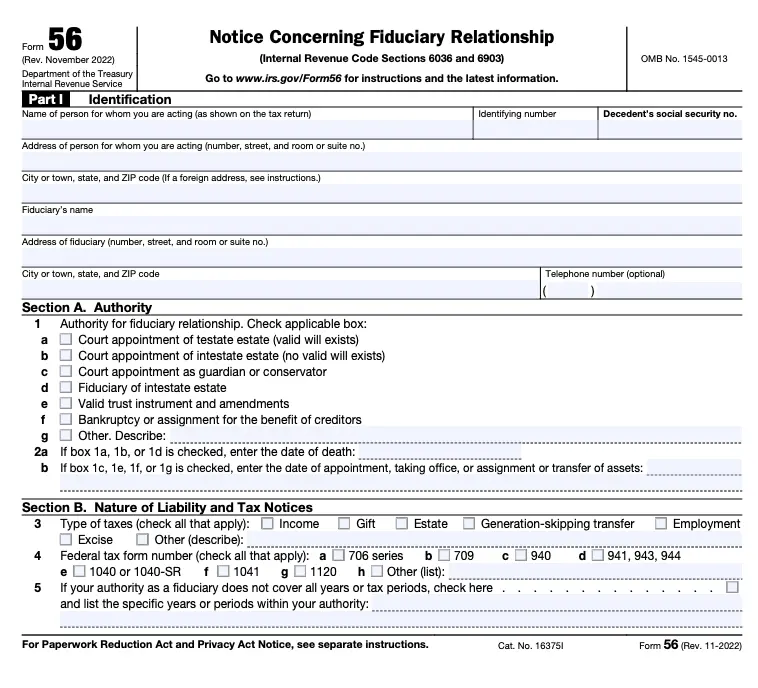Establishing a fiduciary relationship involves notifying the Internal Revenue Service (IRS) through Form 56. This form informs the IRS of the creation or termination of a fiduciary relationship, ensuring that tax matters are directed appropriately. This guide provides detailed Form 56 instructions to help you navigate the process effectively.
Understanding IRS Form 56
Form 56, titled “Notice Concerning Fiduciary Relationship,” is utilized to notify the IRS about the establishment or termination of a fiduciary relationship under section 6903 and to provide notice of qualification under section 6036. A fiduciary is an individual or entity appointed to manage the financial affairs of another person or entity, such as in cases of estates, trusts, or guardianships. Properly completing and submitting Form 56 ensures that the IRS recognizes the fiduciary’s authority to act on behalf of the taxpayer.

Who Should File Form 56?
Individuals or entities assuming a fiduciary role, such as executors, administrators, guardians, conservators, or trustees, are required to file Form 56. This includes situations where the individual is managing the affairs of a minor, an incapacitated person, a deceased individual, or any entity unable to handle its own financial matters. It’s important to note that Form 56 is not required for:
- Fiduciaries acting solely under a power of attorney.
- Bankruptcy trustees, receivers, or assignees for the benefit of creditors.
- Agents or representatives not acting in a fiduciary capacity.
- Individuals acting as custodians under the Uniform Transfers to Minors Act or the Uniform Gifts to Minors Act.
- Trustees of specific tax-exempt organizations.
Understanding whether your role necessitates filing Form 56 is crucial to ensure compliance with IRS regulations.
Step-by-Step Instructions for Completing Form 56
Accurately completing Form 56 involves several key sections. Follow these steps to ensure the form is filled out correctly:
1. Provide Identification Information
Begin by entering the identifying details of both the fiduciary and the individual or entity for whom you are acting:
- Name and Address of the Person for Whom You Are Acting: Include the full legal name and complete mailing address.
- Identifying Number: Enter the Social Security Number (SSN), Employer Identification Number (EIN), or Individual Taxpayer Identification Number (ITIN) of the person or entity.
- Fiduciary’s Name and Address: Provide your full legal name and complete mailing address.
- Telephone Number: Optionally, include your contact number for any follow-up inquiries.
Ensuring this information is accurate is vital for proper processing by the IRS.
2. Indicate the Authority for the Fiduciary Relationship
Specify the basis of your fiduciary authority by checking the appropriate box:
- Court Appointment of Testate Estate: Indicate if appointed by a court for an estate with a valid will.
- Court Appointment of Intestate Estate: Select if appointed for an estate without a valid will.
- Court Appointment as Guardian or Conservator: Choose if appointed to manage the affairs of an individual deemed incapable.
- Other: Specify any other basis for your fiduciary authority not covered above.
Clearly defining your authority helps the IRS understand the context of your fiduciary role.
3. Outline the Nature of Liability and Tax Notices
Detail the scope of your fiduciary responsibility:
- Type of Taxes: Indicate the specific taxes you are responsible for managing (e.g., income tax, estate tax).
- Tax Form Number: Specify the form numbers related to the taxes under your fiduciary duties.
- Year(s) or Period(s): List the tax years or periods your fiduciary relationship covers.
This section ensures that all relevant tax matters are directed to you as the fiduciary.

4. Address Revocation or Termination of Prior Notices (If Applicable)
If you are revoking or terminating a previous fiduciary relationship, complete this section:
- Revocation or Termination: Check the box if you are ending a prior fiduciary relationship.
- Reason for Termination: Indicate the cause, such as court order or completion of duties.
Properly notifying the IRS of the termination ensures that you are no longer held responsible for the taxpayer’s affairs.
5. Provide Court and Administrative Proceeding Details (If Applicable)
If your fiduciary appointment resulted from a court order or administrative proceeding, provide the following information:
- Docket Number: Enter the case number assigned by the court.
- Date of Appointment: Specify the date you were officially appointed as fiduciary.
- Court Name and Address: Provide the full name and address of the court overseeing the proceeding.
Including these details establishes the legal basis for your fiduciary.
6. Complete Part II: Revocation or Termination of Notice
If you are ending a fiduciary relationship previously reported to the IRS, fill out this section:
- Section A – Revocation or Termination: Check the box if you are revoking or terminating a prior notice concerning a fiduciary relationship.
- Date: Enter the date the fiduciary relationship ended.
- Reason: Provide the reason for termination, such as completion of duties, court order, or resignation.
Accurately completing this section ensures that the IRS updates its records to reflect the termination of your fiduciary responsibilities.
7. Fill Out Part III: Court and Administrative Proceedings
This part is necessary if your fiduciary appointment is due to court or administrative proceedings:
- Docket Number: Provide the case or docket number assigned by the court.
- Date Proceedings Initiated: Enter the date when the proceedings began.
- Name and Address of Court: Include the full name and address of the court overseeing the proceedings.
Providing these details establishes the legal basis for your fiduciary role and ensures proper documentation.
8. Sign and Date the Form
In Part IV, certify the accuracy of the information:
- Signature: Sign the form to affirm that all provided information is correct.
- Title: Indicate your official capacity (e.g., executor, trustee, guardian).
- Date: Enter the date you signed the form.
Your signature finalizes the form, making it a legally binding document.
Filing the Form
After completing Form 56, submit it to the appropriate IRS office:
- Where to File: Mail the form to the IRS Service Center, where the person for whom you are acting is required to file tax returns.
- When to File: File Form 56 as soon as you assume your fiduciary role to ensure timely notification.
Timely filing is crucial to establish your authority and receive pertinent tax information.
Importance of Professional Tax Services
Navigating fiduciary responsibilities and tax obligations can be complex. Engaging professional tax services can provide the following:
- Expert Guidance: Ensuring compliance with tax laws and regulations.
- Accurate Filing: Minimizing errors in tax documents and filings.
- Peace of Mind: This allows you to focus on your fiduciary duties without worrying about tax compliance issues.
Professional assistance can be invaluable in managing the intricacies of fiduciary tax obligations.

Conclusion
Completing and filing IRS Form 56 is a critical step in establishing or terminating a fiduciary relationship. By following the detailed instructions provided in this guide, you can ensure compliance with IRS requirements and effectively manage your fiduciary responsibilities. When in doubt, consulting with tax professionals can provide additional support and clarity.










